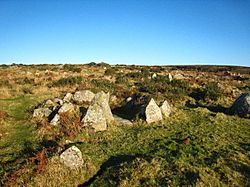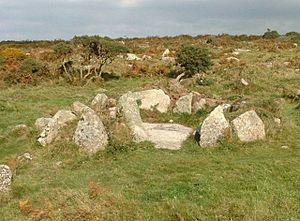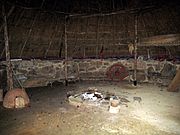Bodrifty facts for kids
Quick facts for kids Bodrifty |
|
|---|---|
 |
|
| Lua error in Module:Location_map at line 530: Unable to find the specified location map definition: "Module:Location map/data/Cornwall (mainland)" does not exist. | |
| Unitary authority | |
| Ceremonial county | |
| Region | |
| Country | England |
| Sovereign state | United Kingdom |
| Police | Devon and Cornwall |
| Fire | Cornwall |
| Ambulance | South Western |
| EU Parliament | South West England |
Bodrifty is the modern name for an ancient village from the Iron Age in Cornwall, England. Today, it's mostly ruins, but it was once a busy settlement. It's located about 3 miles northwest of Penzance, on high ground between the Atlantic Ocean and the English Channel. The site is now part of a farm near the village of New Mill.
A Look Back in Time: Bodrifty's History
Historians believe Bodrifty was first settled a very long time ago. Some think it started around the seventh century BC. Others suggest it began as an open settlement in the fourth century BC.
During the Iron Age, people lived in Bodrifty. They were mostly farmers who grew crops in small fields. They lived in special round huts. The village was very active between the fifth and second centuries BC. It's even said that Pytheas, a famous Greek explorer, visited Bodrifty around 320 BC.
Uncovering the Past: Archaeology at Bodrifty
Bodrifty is an important place for archaeologists. They have found many pieces of pottery here. These pottery pieces, called shards, tell us a lot about the people who lived there.
Archaeologists dug up the site in the early 1950s. Most of the things they found are now in the Royal Cornwall Museum in Truro. By studying the pottery styles, experts believe people lived in Bodrifty from the fifth century BC until the first or second century AD.
The ancient village had eight buildings. A stone wall surrounded them, covering about three acres of land. The buildings themselves were round, with inside spaces measuring between three and eight meters across. The name "Bodrifty" might mean "the house by the summer shed" in the Cornish language.
Building a Roundhouse: A Modern Replica
In 1999, a local farmer named Fred Mustill built a copy of an ancient roundhouse at Bodrifty Farm. He received a small grant to help with the project.
Building the replica was a huge job. It involved moving very heavy granite rocks. He also had to cut, shape, and tie together hundreds of feet of timber for the roof. Then, he spent many hours cutting reeds to make the roof waterproof.
Fred Mustill had studied how ancient roundhouses were built. He also looked at other reconstructed houses in Cornwall. He used traditional materials, like granite sub-soil for the mortar. For the roof, he used woods such as oak, ash, holly, and hazel.
Fred wanted the roundhouse to be a place for learning. He hoped it would help local children and others learn about history and archaeology. By 2011, it was being used for "luxury camping."




